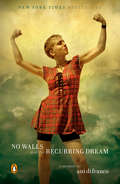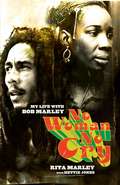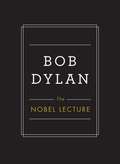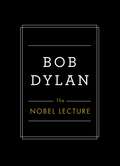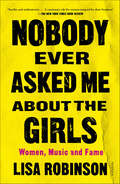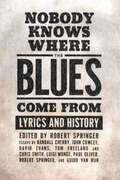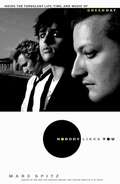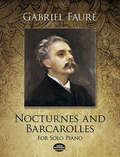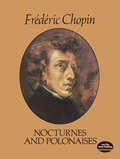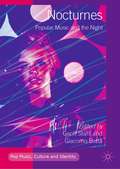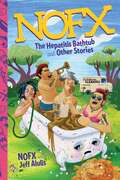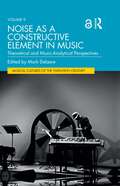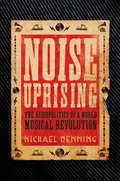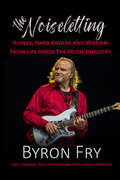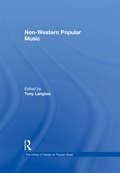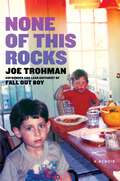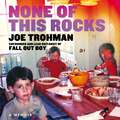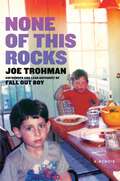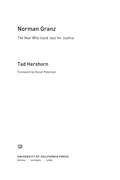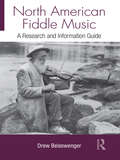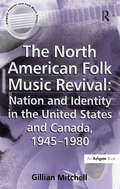- Table View
- List View
No Walls and the Recurring Dream: A Memoir
by Ani DiFrancoA memoir by the celebrated singer-songwriter and social activist Ani DiFranco <P><P>In her new memoir, No Walls and the Recurring Dream, Ani DiFranco recounts her early life from a place of hard-won wisdom, combining personal expression, the power of music, feminism, political activism, storytelling, philanthropy, entrepreneurship, and much more into an inspiring whole. In these frank, honest, passionate, and often funny pages is the tale of one woman's eventful and radical journey to the age of thirty. <P><P>Ani's coming of age story is defined by her ethos of fierce independence--from being an emancipated minor sleeping in a Buffalo bus station, to unwaveringly building a career through appearances at small clubs and festivals, to releasing her first album at the age of 18, to consciously rejecting the mainstream recording industry and creating her own label, Righteous Babe Records. In these pages, as in life, she never hesitates to question established rules and expectations, maintaining a level of artistic integrity that has inspired and challenged more than a few. <P><P>Ani continues to be a major touring and recording artist as well as a celebrated activist and feminist, standing as living proof that you can overcome all personal and societal obstacles to be who you are and to follow your dreams. <P><b>A New York Times Bestseller</b>
No Woman No Cry: My Life with Bob Marley
by Rita MarleyA memoir by the woman who knew Bob Marley best--his wife, Rita.Rita Marley grew up in the slums of Trench Town, Jamaica. Abandoned by her mother at a very young age, she was raised by her aunt. Music ran in Rita's family, and even as a child her talent for singing was pronounced. By the age of 18, Rita was an unwed mother, and it was then that she met Bob Marley at a recording studio in Trench Town. Bob and Rita became close friends, fell in love, and soon, she and her girlfriends were singing backup for the Wailers. At the ages of 21 and 19, Bob and Rita were married.The rest is history: Bob Marley and the Wailers set Jamaica and the world on fire. But while Rita displayed blazing courage, joy, and an indisputable devotion to her husband, life with Bob was not easy. There were his liaisons with other women--some of which produced children and were conducted under Rita's roof. The press repeatedly reported that Bob was unmarried to preserve his "image." But Rita kept her self-respect, and when Bob succumbed to cancer in 1981, she was at his side. In the years that followed, she became a force in her own right--as the Bob Marley Foundation's spokesperson and a performer in her reggae group, the I-Three.Written with author Hettie Jones, No Woman No Cry is a no-holds-barred account of life with one of the most famous musicians of all time. In No Woman No Cry, readers will learn about the never-before-told details of Bob Marley's life, including: How Rita practiced subsistence farming when first married to Bob to have food for her family. How Rita rode her bicycle into town with copies of Bob's latest songs to sell. How Rita worked as a housekeeper in Delaware to help support her family when her children were young. Why Rita chose to befriend some of the women with whom Bob had affairs and to give them advice on rearing the children they had with Bob. The story of the attack on Bob which almost killed the two of them. Bob's last wishes, dreams, and hopes, as well as the details of his death, such as who came to the funeral (and who didn't).
The Nobel Lecture
by Bob DylanOn October 13, 2016, it was announced that Bob Dylan had been awarded the Nobel Prize for Literature, recognizing his countless contributions to music and letters over the last fifty years. Some months later, he delivered a lecture that will now be available in book form for generations to come. In it, he reflects on his life and experience with literature, giving readers a rare and intimate look at an American icon. From being inspired by Buddy Holly to the novels that helped shape his own approach to writing (The Odyssey, Moby Dick, and All Quiet on the Western Front), this is Dylan like you've never seen him before.
The Nobel Lecture
by Bob DylanPublished for the first time in a beautiful collectible edition, the essential lecture delivered by the 2016 recipient of the Nobel Prize in Literature, Bob Dylan.On October 13, 2016, Bob Dylan was awarded the Nobel Prize in Literature, recognizing his countless contributions to music and letters over the last fifty years. Some months later, he delivered an acceptance lecture that is now memorialized in book form for generations to come. In The Nobel Lecture, Dylan reflects on his life and experience with literature, providing both a rare artistic statement and an intimate look at a uniquely American icon. From finding inspiration in the music of Buddy Holly and Leadbelly to the works of literature that helped shape his own approach to writing—The Odyssey, Moby-Dick, and All Quiet on the Western Front—this is Dylan like you’ve never seen him before.
Nobody Ever Asked Me about the Girls: Women, Music and Fame
by Lisa Robinson"Indispensable [reading] about the feminine journey through a man's world"—USA TodayAn intimate look at the lives of our most celebrated female musicians—and their challenges with fame—from a legendary music journalistOver four decades, Lisa Robinson has made a name for herself as a celebrated journalist in a business long known for its boys’ club mentality. But to Robinson, the female performers who sat down with her, most often at the peak of their careers, were the true revelations.Based on conversations with more than forty female artists, Nobody Ever Asked Me about the Girls is a behind-the-scenes glimpse into the effects of success on some of music’s most famous women. From Tina Turner, Joni Mitchell, Stevie Nicks, Donna Summer, Bette Midler, Alanis Morissette and Linda Ronstadt to Mary J. Blige, Lady Gaga, Jennifer Lopez, Adele, Beyoncé, Rihanna, and numerous others, Robinson reveals the private obsessions and public distractions that musicians contend with in their pursuit of stardom. From these interviews emerge candid portraits of how these women—regardless of genre or decade—deal with image, abuse, love, motherhood, family, sex, drugs, business, and age. Complete with reflections from Robinson’s own career as a pioneering female music writer, Nobody Ever Asked Me about the Girls offers an overdue consideration of how hopes, dreams, and the drive for recognition have propelled our most beloved female musicians to take the stage and leave an undeniable, lasting musical mark on the world.
Nobody Knows Where the Blues Come From: Lyrics and History (American Made Music Series)
by Robert SpringerMusicians and music scholars rightly focus on the sounds of the blues and the colorful life stories of blues performers. Equally important and, until now, inadequately studied are the lyrics. The international contributors to Nobody Knows Where the Blues Come From explore this aspect of the blues and establish the significance of African American popular song as a neglected form of oral history.“High Water Everywhere: Blues and Gospel Commentary on the 1927 Mississippi River Flood,” by David Evans, is the definitive study of songs about one of the greatest natural disasters in the history of the United States. In “Death by Fire: African American Popular Music on the Natchez Rhythm Club Fire,” Luigi Monge analyzes a continuum of songs about exclusively African American tragedy. “Lookin’ for the Bully: An Enquiry into a Song and Its Story,” by Paul Oliver traces the origins and the many avatars of the Bully song. In “That Dry Creek Eaton Clan: A North Mississippi Murder Ballad of the 1930s,” Tom Freeland and Chris Smith study a ballad recorded in 1939 by a black convict at Parchman prison farm. “Coolidge’s Blues: African American Blues from the Roaring Twenties” is Guido van Rijn’s survey of blues of that decade. Robert Springer's “On the Electronic Trail of Blues Formulas” presents a number of conclusions about the spread of patterns in blues narratives. In “West Indies Blues: An Historical Overview 1920s-1950s,” John Cowley turns his attention to West Indian songs produced on the American mainland. Finally, in “Ethel Waters: ‘Long, Lean, Lanky Mama,’” Randall Cherry reappraises the early career of this blues and vaudeville singer
Nobody Likes You: Inside the Turbulent Life, Times, and Music of Green Day
by Marc SpitzThe full story of the rise and spectacular comeback of the band hailed as the saviors of punk rock and the next U2It's hard to believe that in early 2004 Green Day was considered over--the band was still together, but they were dismissed as a strictly 90s phenomenon, incapable of re-creating the success of their groundbreaking album Dookie. Then American Idiot debuted at #1 on the Billboard charts, stayed on the charts for nearly 18 months, and went on to sell more than four million records and to win Record of the Year (for "Boulevard of Broken Dreams") at this year's Grammy's.Combining unique access to Green Day with a seasoned journalist's nose for a great story, Marc Spitz gives the complete account of the band, from their earliest days to their most recent explosion of popularity and critical acclaim. Foremost, Nobody Likes You is a story of friendship and the transporting power of playing very loud music. It is the story of how high school dropout Billie Joe Armstrong came to write song lyrics that inflamed the political conscience of fans in a way that two Yale graduates couldn't. Green Day's story--from rise, to fall, to rise again--has never before been fully told.
Nocturnes and Barcarolles for Solo Piano (Dover Classical Piano Music)
by Gabriel FauréThe music of Gabriel Fauré (1845-1924) is an important link between the innovations of late Romanticism and the experimentation of the early 20th century. A student of Saint-Saëns, he, in turn, taught Ravel and was a mentor to the young modernists of Les Six. These 12 nocturnes and 12 barcarolles, composed over a span of 40 years, document his move from Romanticism to the frontiers of 20th-century music. Reprinted from authoritative French editions.
Nocturnes and Polonaises
by Frédéric ChopinOne of the most respected editions of Chopin's works was prepared by Carl Mikuli, Chopin's student and teaching assistant. His editorial contributions to this volume reflect his understanding of the principles imparted to him in word and deed by the composer. The 20 nocturnes reproduced here include Opp. 9, 15, 27, 32, 37, 48, 55, 62, 72, and the posthumous Nocturne in C-sharp Minor. The 11 polonaises include Opp. 26, 40, 44, 53, 61, 71, and the posthumous Polonaise in G-sharp Minor. Serious pianists will want to have these authoritative texts of 31 of Chopin's most popular and enduring works, reprinted from an authoritative early edition. New unified table of contents.
Nocturnes: Popular Music and the Night (Pop Music, Culture and Identity)
by Geoff Stahl Giacomo BottàThe night and popular music have long served to energise one another, such that they appear inextricably bound together as trope and topos. This history of reciprocity has produced a range of resonant and compelling imaginaries, conjured up through countless songs and spaces dedicated to musical life after dark. Nocturnes: Popular Music and the Night is one of the first volumes to examine the relationship between night and popular music. Its scope is interdisciplinary and geographically diverse. The contributors gathered here explore how the problems, promises, and paradoxes of the night and music play off of one another to produce spaces of solace and sanctuary as well as underpinning strategies designed to police, surveil and control movements and bodies. This edited collection is a welcome addition to debates and discussions about the cultures of the night and how popular music plays a continuing role in shaping them.
NOFX: The Hepatitis Bathtub and Other Stories
by Jeff Alulis Nofx<P>NOFX: The Hepatitis Bathtub and Other Stories is the first tell-all autobiography from one of the world's most influential and controversial punk bands. Alongside hilarious anecdotes about pranks and drunkenness and teenage failures-featuring the trademark NOFX sense of humor-the book also shares the ugliness and horror the band members experienced on the road to becoming DIY millionaires. <P>Fans and non-fans alike will be shocked by stories of murder, suicide, addiction, counterfeiting, riots, bondage, terminal illness, the Yakuza, and pee...lots and lots of pee. Told by each of the band members (and two former members), NOFX looks back at more than thirty years of comedy, tragedy, and completely inexplicable success. <P><b>A New York Times Bestseller</b>
Noise as a Constructive Element in Music: Theoretical and Music-Analytical Perspectives (Musical Cultures of the Twentieth Century)
by Mark DelaereMusic and noise seem to be mutually exclusive. Music is generally considered as an ordered arrangement of sounds pleasing to the ear and noise as its opposite: chaotic, ugly, aggressive, sometimes even deafening. When presented in a musical context, noise can thus act as a tool to express resistance to predominant cultural values, to society or to socioeconomic structures (including those of the music industry). The oppositional stance confirms current notions of noise as something which is destructive, a belief not only cherished by hard-core rock bands but also shared by engineers and companies developing devices to suppress or reduce noise in our daily environment. In contrast to the common opinions on noise just described, this volume seeks to explore the constructive potential of noise in contemporary musical practices. Rather than viewing noise as a ‘defect’, this volume aims at studying its aesthetic and cultural potential. Within the noise music study field, most recent publications focus on subgenres such as psychedelic post-rock, industrial, hard-core punk, trash or rave, as they developed from rock and popular music. This book includes work on avant-garde music developed in the domain of classical music as well. In addition to already well-established (social) historical and aesthetical perspectives on noise and noise music, this volume offers contributions by music analysts.
Noise as a Constructive Element in Music: Theoretical and Music-Analytical Perspectives (Musical Cultures of the Twentieth Century)
by Mark DelaereMusic and noise seem to be mutually exclusive. Music is generally considered as an ordered arrangement of sounds pleasing to the ear and noise as its opposite: chaotic, ugly, aggressive, sometimes even deafening. When presented in a musical context, noise can thus act as a tool to express resistance to predominant cultural values, to society or to socioeconomic structures (including those of the music industry). The oppositional stance confirms current notions of noise as something which is destructive, a belief not only cherished by hard-core rock bands but also shared by engineers and companies developing devices to suppress or reduce noise in our daily environment.In contrast to the common opinions on noise just described, this volume seeks to explore the constructive potential of noise in contemporary musical practices. Rather than viewing noise as a ‘defect’, this volume aims at studying its aesthetic and cultural potential.Within the noise music study field, most recent publications focus on subgenres such as psychedelic post-rock, industrial, hard-core punk, trash or rave, as they developed from rock and popular music. This book includes work on avant-garde music developed in the domain of classical music as well. In addition to already well-established (social) historical and aesthetical perspectives on noise and noise music, this volume offers contributions by music analysts.
Noise Uprising
by Michael DenningA radically new reading of the origins of recorded music Noise Uprising brings to life the moment and sounds of a cultural revolution. Between the development of electrical recording in 1925 and the outset of the Great Depression in the early 1930s, the soundscape of modern times unfolded in a series of obscure recording sessions, as hundreds of unknown musicians entered makeshift studios to record the melodies and rhythms of urban streets and dancehalls. The musical styles and idioms etched onto shellac disks reverberated around the globe: among them Havana's son, Rio's samba, New Orleans' jazz, Buenos Aires' tango, Seville's flamenco, Cairo's tarab, Johannesburg's marabi, Jakarta's kroncong, and Honolulu's hula. They triggered the first great battle over popular music and became the soundtrack to decolonization.From the Trade Paperback edition.
Noiseletting: Hijinks, Hard Knocks, and Wisdom from Life Inside the Music Industry
by Byron FryWhatever you do or don't know about being a musician, this no-holds-barred tour through the hilarious and brutal realities of life inside the musicindustry is as informative as it is entertaining. Written for musicians andgeneral public alike, Byron Fry's story imparts hard-learned, hard-hittingtruths from his wild ride through life as a musical pinball.
Non-Western Popular Music (The\library Of Essays On Popular Music Ser.)
by Tony LangloisThis collection provides readers with a diverse and contemporary overview of research in the field. Drawing upon scholarly writing from a range of disciplines and approaches, it provides case studies from a wide range of 'non Western' musical contexts. In so doing the volume attends to the central themes that have emerged in this area of popular music studies; cultural politics, identity and the role of technology. This collection does not seek to establish a new theoretical paradigm, but being primarily aimed at researchers and students, offers as comprehensive a view of the research that has been carried out over the last few decades as possible, given the global scope of the subject. Inevitably, the experience of globalisation itself runs through many of the contributions, not only because musicians find themselves part of an immense flow of international culture, technology and finance, but also because Western scholarship can also be considered an aspect of such a flow. The articles selected for the volume take different disciplinary approaches; many are close ethnographic descriptions of musical practices whilst others take a more historical view of a musical 'scene' or even a single musician. Some essays consider the effects of emerging technologies upon the production, dissemination and consumption of music, whilst the political context is central to other authors. The collection as a whole serves as a resource for those who wish to be better acquainted with the diversity of research that has been carried out into non-western pop, whilst also highlighting the broader themes that have, so far, shaped academic approaches to the subject.
None But the Lonely Heart and Other Songs for High Voice (Dover Song Collections)
by Peter Ilyitch TchaikovskyOne of the most expressive and versatile of the great nineteenth-century Romantic composers, Peter Ilyitch Tchaikovsky brought a sense of intimacy and emotional power to all of his music — whether for orchestra, opera, ballet, or art song. Grove's Dictionary of Music and Musicians remarks on the characteristic charm of Tchaikovsky's songs, noting their "penetrating sweetness and sadness" as well as their "vocal excellence."In addition to the celebrated title work, this collection presents a rich selection of 40 enchanting melodies, including Don Juan's Serenade, Mignon's Song, Night of Stars, Serenade, Song of the Gipsy Girl, and other exquisite pieces for voice and piano. Featured texts by Goethe, Heine, Tolstoy, and other great poets appear in English and either German or French.
None of this Rocks: The brilliant first memoir by Fall Out Boy guitarist Joe Trohman
by Joe TrohmanNone of This Rocks is a memoir by Joe Trohman - lead guitarist and cofounder of Fall Out Boy - that reads like a double album full of revealing stories from his youth and his experiences of modern rock and roll stardom. With wit and wisdom, and maybe a little bit of whining, Trohman grapples with depression, his mother's brain cancer, antisemitism, pills, petty larceny, side hustles, and pop punk at the turn of the century. None of This Rocks chronicles a turbulent life that has informed Trohman's music and his worldview. His mother suffered from mental illness and multiple brain tumors that eventually killed her. His father struggled with that tragedy, but was ultimately a supportive force in Trohman's life who fostered his thirst for knowledge. Trohman faced antisemitism in small-town Ohio, and he witnessed all levels of misogyny, racism, and violence amid the straight edge hardcore punk scene in Chicago. Then came Fall Out Boy. From the guitarist's very first glimpses of their popular ascension, to working with his heroes like Anthrax's Scott Ian, to writing for television with comedian Brian Posehn, Trohman takes readers backstage, into the studio, and onto his couch. He shares his struggles with depression and substance abuse in a brutally honest and personal tone that readers will appreciate. Not much of this rocks, perhaps, but it all adds up to a fascinating music memoir unlike any you've ever read.
None of this Rocks: The brilliant first memoir by Fall Out Boy guitarist Joe Trohman
by Joe TrohmanNone of This Rocks is a memoir by Joe Trohman - lead guitarist and cofounder of Fall Out Boy - that reads like a double album full of revealing stories from his youth and his experiences of modern rock and roll stardom. With wit and wisdom, and maybe a little bit of whining, Trohman grapples with depression, his mother's brain cancer, antisemitism, pills, petty larceny, side hustles, and pop punk at the turn of the century. None of This Rocks chronicles a turbulent life that has informed Trohman's music and his worldview. His mother suffered from mental illness and multiple brain tumors that eventually killed her. His father struggled with that tragedy, but was ultimately a supportive force in Trohman's life who fostered his thirst for knowledge. Trohman faced antisemitism in small-town Ohio, and he witnessed all levels of misogyny, racism, and violence amid the straight edge hardcore punk scene in Chicago. Then came Fall Out Boy. From the guitarist's very first glimpses of their popular ascension, to working with his heroes like Anthrax's Scott Ian, to writing for television with comedian Brian Posehn, Trohman takes listeners backstage, into the studio, and onto his couch. He shares his struggles with depression and substance abuse in a brutally honest and personal tone that listeners will appreciate. Not much of this rocks, perhaps, but it all adds up to a fascinating music memoir unlike any you've ever heard.(P) 2022 Hachette Audio
None of This Rocks: A Memoir
by Joe TrohmanLead guitarist and cofounder of Fall Out Boy shares personal stories from his youth and his experiences of modern rock and roll stardom in this memoir filled with wit and wisdom. Trohman cofounded Fall Out Boy with Pete Wentz in the early aughts, and he&’s been the sticky element of the metaphorical glue-like substance holding the band together ever since, over the course of a couple decades that have included massive success, occasional backlashes, and one infamous four-year hiatus. Trohman was, and remains, the emotive communicator of the group: the one who made sure they practiced, who copied and distributed the flyers, and who took the wheel throughout many of the early tours. As soon as he was old enough to drive, that is—because he was all of 15 years old when they started out. That&’s part of the story Trohman tells in this memoir, which provides an indispensable inside perspective on the history of Fall Out Boy for their legions of fans. But Trohman has a great deal more to convey, thanks to his storytelling chops, his unmistakable voice, and his unmitigated sense of humor in the face of the tragic and the absurd. None of This Rocks chronicles a turbulent life that has informed Trohman&’s music and his worldview. His mother suffered from mental illness and multiple brain tumors that eventually killed her. His father struggled with that tragedy, but was ultimately a supportive force in Trohman&’s life who fostered his thirst for knowledge. Trohman faced antisemitism in small-town Ohio, and he witnessed all levels of misogyny, racism, and violence amid the straight edge hardcore punk scene in Chicago. Then came Fall Out Boy. From the guitarist&’s very first glimpses of their popular ascension, to working with his heroes like Anthrax&’s Scott Ian, to writing for television with comedian Brian Posehn, Trohman takes readers backstage, into the studio, and onto his couch. He shares his struggles with depression and substance abuse in a brutally honest and personal tone that readers will appreciate. Not much of this rocks, perhaps, but it all adds up to a fascinating music memoir unlike any you&’ve ever read.
Norman Granz: The Man Who Used Jazz for Justice
by Tad Hershorn"Any book on my life would start with my basic philosophy of fighting racial prejudice. I loved jazz, and jazz was my way of doing that," Norman Granz told Tad Hershorn during the final interviews given for this book. Granz, who died in 2001, was iconoclastic, independent, immensely influential, often thoroughly unpleasant--and one of jazz's true giants. Granz played an essential part in bringing jazz to audiences around the world, defying racial and social prejudice as he did so, and demanding that African-American performers be treated equally everywhere they toured. In this definitive biography, Hershorn recounts Granz's story: creator of the legendary jam session concerts known as Jazz at the Philharmonic; founder of the Verve record label; pioneer of live recordings and worldwide jazz concert tours; manager and recording producer for numerous stars, including Ella Fitzgerald and Oscar Peterson.
North American Fiddle Music: A Research and Information Guide (Routledge Music Bibliographies)
by Drew BeisswengerNorth American Fiddle Music: A Research and Information Guide is the first large-scale annotated bibliography and research guide on the fiddle traditions of the United States and Canada. These countries, both of which have large immigrant populations as well as Native populations, have maintained fiddle traditions that, while sometimes faithful to old-world or Native styles, often feature blended elements from various traditions. Therefore, researchers of the fiddle traditions in these two countries can not only explore elements of fiddling practices drawn from various regions of the world, but also look at how different fiddle traditions can interact and change. In addition to including short essays and listings of resources about the full range of fiddle traditions in those two countries, it also discusses selected resources about fiddle traditions in other countries that have influenced the traditions in the United States and Canada.
The North American Folk Music Revival: Nation and Identity in the United States and Canada, 1945–1980 (Ashgate Popular and Folk Music Series)
by Gillian MitchellThis work represents the first comparative study of the folk revival movement in Anglophone Canada and the United States and combines this with discussion of the way folk music intersected with, and was structured by, conceptions of national affinity and national identity. Based on original archival research carried out principally in Toronto, Washington and Ottawa, it is a thematic, rather than general, study of the movement which has been influenced by various academic disciplines, including history, musicology and folklore. Dr Gillian Mitchell begins with an introduction that provides vital context for the subject by tracing the development of the idea of 'the folk', folklore and folk music since the nineteenth century, and how that idea has been applied in the North American context, before going on to examine links forged by folksong collectors, artists and musicians between folk music and national identity during the early twentieth century. With the 'boom' of the revival in the early sixties came the ways in which the movement in both countries proudly promoted a vision of nation that was inclusive, pluralistic and eclectic. It was a vision which proved compatible with both Canada and America, enabling both countries to explore a diversity of music without exclusiveness or narrowness of focus. It was also closely linked to the idealism of the grassroots political movements of the early 1960s, such as integrationist civil rights, and the early student movement. After 1965 this inclusive vision of nation in folk music began to wane. While the celebrations of the Centennial in Canada led to a re-emphasis on the 'Canadianness' of Canadian folk music, the turbulent events in the United States led many ex-revivalists to turn away from politics and embrace new identities as introspective singer-songwriters. Many of those who remained interested in traditional folk music styles, such as Celtic or Klezmer music, tended to be very insular and conservative in their approach, rather than linking their chosen genre to a wider world of folk music; however, more recent attempts at 'fusion' or 'world' music suggest a return to the eclectic spirit of the 1960s folk revival. Thus, from 1945 to 1980, folk music in Canada and America experienced an evolving and complex relationship with the concepts of nation and national identity. Students will find the book useful as an introduction, not only to key themes in the folk revival, but also to concepts in the study of national identity and to topics in American and Canadian cultural history. Academic specialists will encounter an alternative perspective from the more general, broad approach offered by earlier histories of the folk revival movement.
North American Indian Music: A Guide to Published Sources and Selected Recordings (Routledge Music Bibliographies #Vol. 5)
by Richard KeelingFirst Published in 1997. Routledge is an imprint of Taylor & Francis, an informa company.
North Carolina String Music Masters: Old-Time and Bluegrass Legends
by Elizabeth A. Carlson Former Npr BrownThe roots of American music are deeply grounded in North Carolina's music history. North Carolina musicians pioneered and mastered the genres of old-time and bluegrass music. Doc Watson played mountain fiddle tunes on guitar. He emerged as the father of flatpicking and forever changed the role of the guitar in American music. Charlie Poole created techniques that eventually defined bluegrass, and folks around the state heard his banjo on some of the most important old-time recordings. Rising star Rhiannon Giddens keeps the music alive today through new interpretations of classic old-time and bluegrass songs. Elizabeth Carlson profiles these and other masters of string music in this fascinating record of North Carolina's musical past, present and future.
